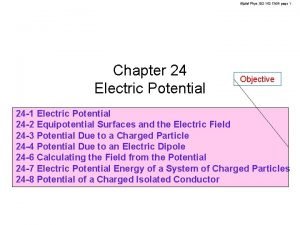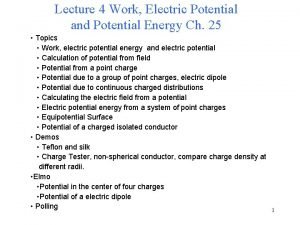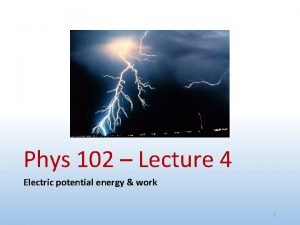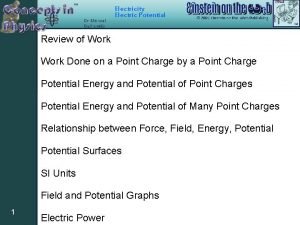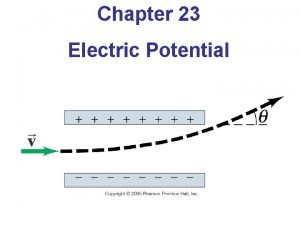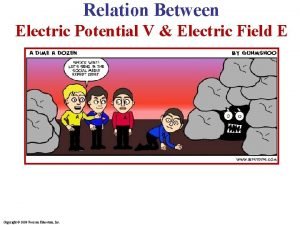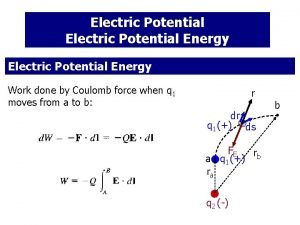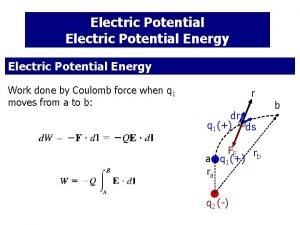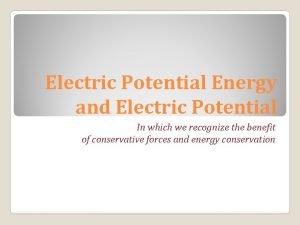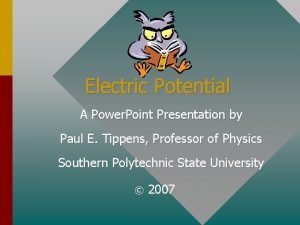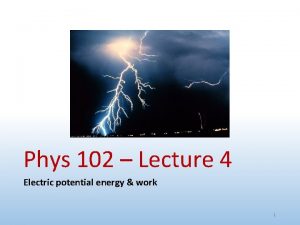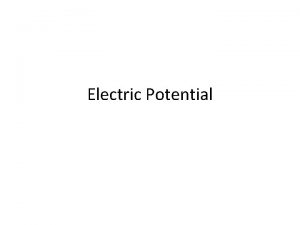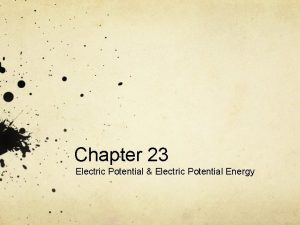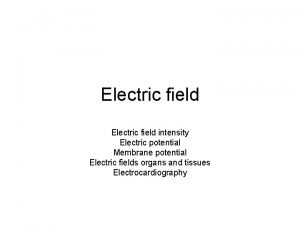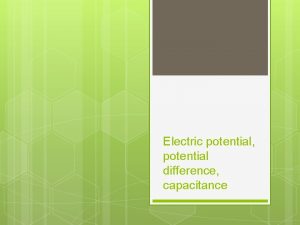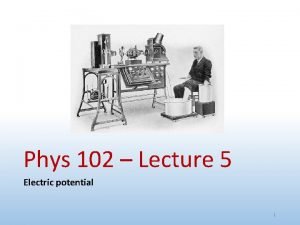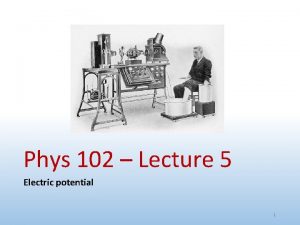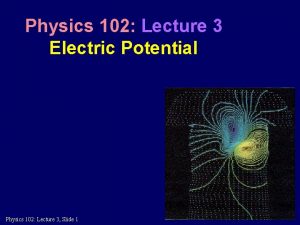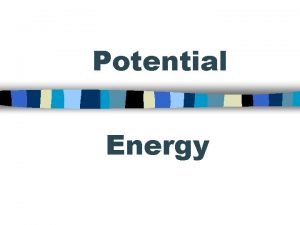Phys 102 Lecture 4 Electric potential energy work





















- Slides: 21

Phys 102 – Lecture 4 Electric potential energy & work 1

Today we will. . . • Learn about the electric potential energy • Relate it to work Ex: charge in uniform electric field, point charges • Apply these concepts Ex: electron microscope, assembly of point charges, dipole energy Phys. 102, Lecture 3, Slide 2

Potential energy U – stored energy, can convert to kinetic energy K Review Phys. 101 x h Gravitational potential energy (ex: falling object) Elastic potential energy (ex: spring) Total energy K + U is conserved Same ideas apply to electricity + r + Electric potential energy (ex: repelling charges) Phys. 102, Lecture 3, Slide 3

Work Review Phys. 101 Work – transfer of energy when a force acts on a moving object Work done by force F Displacement θ Angle between force Change in potential energy and displacement Units: J (“Joules”) It matters who does the work For conservative forces, work is related to potential energy Phys. 102, Lecture 3, Slide 4

Electric potential energy & work Gravity Electricity Mass raised yi yf Charge moved xi xf (in uniform E field to left) down xi yf h yi left d xf + Phys. 102, Lecture 3, Slide 5

Positive and negative work If you moved object against external force (gravitational, electric, etc. ), you did positive work, force did negative work + + Wyou > 0 WF < 0 Wyou < 0 WF > 0 If you moved object along external force (gravitational, electric, etc. ), you did negative work, force did positive work Phys. 102, Lecture 3, Slide 6

Checkpoint 1. 2 C – A B When a negative charge is moved from A to C the ELECTRIC force does A. positive work B. zero work C. negative work Phys. 102, Lecture 3, Slide 7

ACT: Checkpoint 1. 3 C – A B When a negative charge is moved from A to B the ELECTRIC force does A. positive work B. zero work C. negative work Phys. 102, Lecture 3, Slide 8

ACT: Work in a uniform E field C Let WA-B be the answer to the previous problem – A B The negative charge is now moved from A to C to B. The work done by the electric force is A. Greater than WA-B B. Same as WA-B C. Less than WA-B Phys. 102, Lecture 3, Slide 9

Path independence of work A B For conservative forces (ex: gravitational, electric), work is independent of path. Work depends only on end points. Potential energy of charge at position A Potential energy of charge at position B Phys. 102, Lecture 3, Slide 10

Calculation: Electron microscope (revisited) A uniform E field generated by parallel plates accelerates electrons in an electron microscope. If an electron starts from rest at the top plate what is its final velocity? –Q d = 1 cm +Q E = 106 N/C – Electron microscope Phys. 102, Lecture 3, Slide 11

E. P. E of two point charges Electric potential energy of two charges q 1 and q 2 separated by a distance r Note: NOT r 2 +1. 6 x 10– 19 C = q 1 + – q 2 = – 1. 6 x 10– 19 C r = 0. 53 x 10– 10 m Ex: What is the electric potential energy of the proton and the electron in H? Phys. 102, Lecture 3, Slide 12

ACT: E. P. E. of 2 charges In case A, two charges of equal magnitude but opposite sign are separated by a distance d. In case B, they are separated by 2 d. Case A Case B +q +q – + + d –q – –q 2 d Which configuration has a higher electric potential energy? A. Case A has a higher E. P. E. B. Case B has a higher E. P. E. C. Both have the same E. P. E. Phys. 102, Lecture 3, Slide 13

Sign of potential energy What does it mean to have a negative electric potential energy? Ex: H atom – + Electron Proton UE < 0 relative to energy of an electron very far away (r ), away from E field of proton, i. e. a “free” electron UE Energy must be added in order to free electron bound to proton 0 Free electron r Electron bound to proton in H atom Phys. 102, Lecture 3, Slide 14

Calculation: two charges Two +5 C, 1 kg charges are separated by a distance of 2 m. At t = 0 the charge on the right is released from rest (the left charge is fixed). What is the speed of the right charge after a long time (t )? From EX 1, SPRING ‘ 10 +5 C Fixed r=2 m +5 C Free to move Phys. 102, Lecture 3, Slide 15

Work done to assemble charges How much work do you do assembling configuration of charges? q 1 – + q 2 r Imagine bringing charges from infinitely far away to a separation r Potential energy of charges infinitely far Potential energy of charges in final configuration Phys. 102, Lecture 3, Slide 16

Calculation: assembling charges How much work do you do to assemble the charges q 1 = +2 μC, q 2 = +7 μC, and q 3 = – 3. 5 μC into a triangle? q 1 5 m q 2 3 m 4 m 3 m q 3 Phys. 102, Lecture 3, Slide 17

+ d + ACT: Checkpoint 2. 1 Charges of equal magnitude are assembled into an equilateral triangle d d – The total work required by you to assemble this set of charges is: A. positive B. zero C. negative Phys. 102, Lecture 3, Slide 18

Calculation: dipole in E-field An electric dipole with moment p = 6. 2 x 10– 30 C∙m is placed in a uniform external electric field E = 106 N/C at an angle θ = 60°. Calculate the total electric potential energy of the dipole. +q θ = 60° –q Phys. 102, Lecture 3, Slide 19

ACT: dipole energy Which configuration of dipole in a uniform electric field has the lowest electric potential energy? C. –q +q +q –q –q B. +q A. Phys. 102, Lecture 3, Slide 20

Summary of today’s lecture • Electric potential energy & work Path independence Conservation of energy • Electric potential energy for point charges Phys. 102, Lecture 3, Slide 21
 Potential energy of capacitor
Potential energy of capacitor Electric potential energy and potential difference
Electric potential energy and potential difference V=pe/q
V=pe/q Uiuc phys 102
Uiuc phys 102 Aljalal phys 102
Aljalal phys 102 Aljalal phys 102
Aljalal phys 102 Electric field and energy
Electric field and energy Electric potential lecture
Electric potential lecture Physics 102
Physics 102 Equipotential lines
Equipotential lines Electric potential
Electric potential Potential due to an electric dipole
Potential due to an electric dipole Purdue physics 241
Purdue physics 241 Electric potential electric field
Electric potential electric field Can potential energy be negative
Can potential energy be negative Electric potential to work
Electric potential to work Relation between potential energy and electric field
Relation between potential energy and electric field Relationship between v and e
Relationship between v and e Is potential energy the integral of force
Is potential energy the integral of force Work done by coulomb force
Work done by coulomb force Direction of electric potential
Direction of electric potential How to find electric potential energy
How to find electric potential energy




